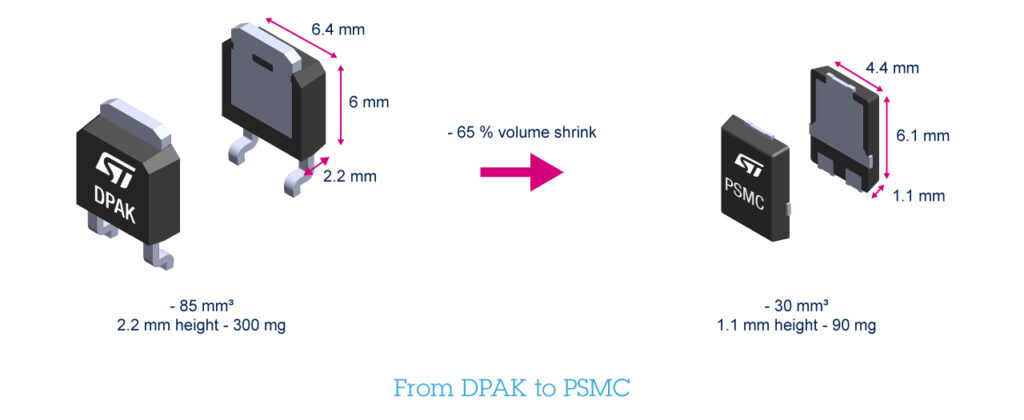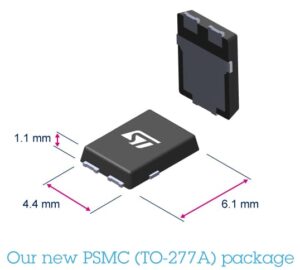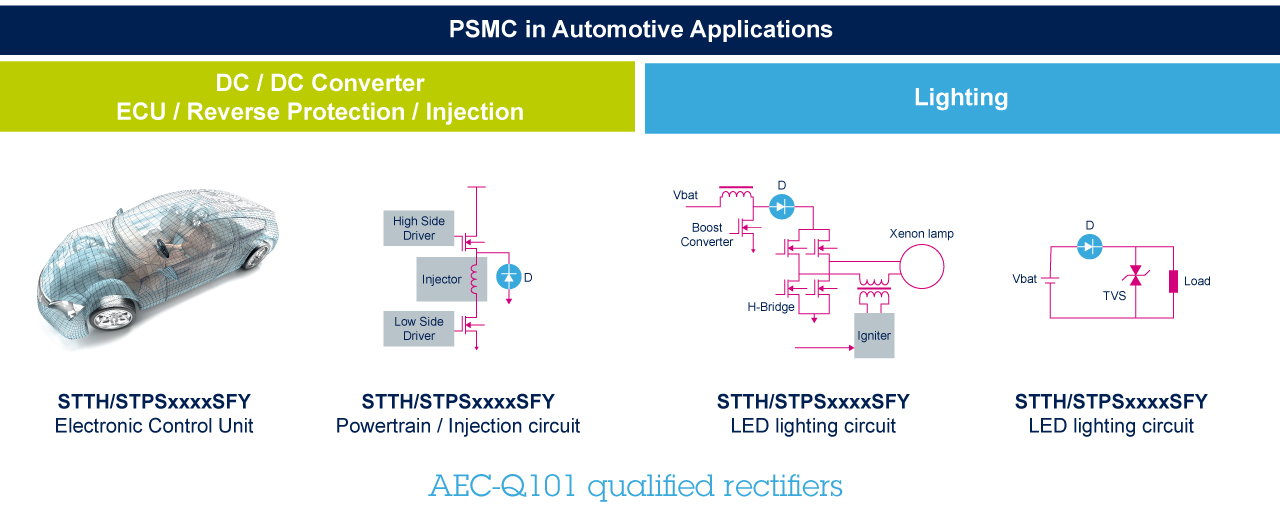Our new family of flat rectifiers with a PSMC (TO-277A) package improves thermal resistance by 15%1, compared to equivalent models using a DPAK housing, which will lead to much smaller and more cost-effective power supplies for phones or laptops, or more efficient power supplies for blade servers or appliances, among many other applications. It also has wettable flanks, which allows manufacturers of automotive products to perform automatic visual inspections of the solder joints, an absolute must in this industry.
Many engineers tend to overlook a company’s transition to a new package, which is a mistake. We showed on many occasions, as with SOD Flat packages, that a new package can open the door to original designs thanks to groundbreaking performance and record form factors, as is the case here since our PSMC packages offer a 65%2 volume reduction compared to their DPAK alter egos.
Environmentally Friendly with New Processes for Better Heat Dissipation
Our new PSMC package is a study in contrast. Compared to their equivalent rectifiers using a Discrete Package (DPAK or TO-252) housing with a thickness of 2.2 mm (0.087 in), the new model is only 1.1 mm (0.043″) thick. Despite the reduction in space, the PSMC model has a thermal resistance at the junction of only 2.1 ºC / W whereas the DPAK device hovers at 2.5 ºC/W3.
Instinctively, engineers will recognize that shrinking a package makes it harder to dissipate heat. However, with our new PSMC package also comes new manufacturing processes that significantly improve the connection between the die, the heatsink, and the housing. Heat dissipation is thus so efficient that we are offering 15% less thermal resistance while also reducing the volume by 65% and the weight by 70%. This shrinkage will enable the creation of smaller PCBs, which has a positive and crucial impact on the environment.

If we put these numbers in perspective, we see that companies are ecstatic when they can get a reduction of 0.2% in thermal resistance. The performance levels offered by the new PSMC housing are thus extraordinary. Aside from the possibilities of creating thinner and smaller products (like power supplies, battery chargers, auxiliary powers, or DC/DC converters), these specifications also improve the total cost of ownership. Wettable flanks help manufacturers save money on production costs, and the performance increase implies that our devices are more reliable at extreme temperatures. For instance, when engineers see that our components have an operating temperate range of -40 ºC to + 175 ºC, they know that thanks to the improvements in thermal dissipation, and the automotive grade certifications, these values are not merely theoretical specifications.
Business Friendly with Wettable Flanks for a Better Soldering Process

Wettable flanks or side wetting is a highly valuable feature because it means that assembly lines do not need to rely on X-ray images to determine if the solder joints between the PCB pads and the component’s pins are of good quality. Conversely, when the solder joint is underneath the component, it’s impossible to visually verify the reliability of the solder bond. Even if there’s a side fillet, meaning that part of the joint forms a meniscus of solder on the side of the chip, manufacturers still require an X-ray to truly be certain. Wettable flanks bypass this issue entirely by offering an area that enables the solder to flow up the pin to offer a well-visible fillet.
An automated visual inspection thus becomes possible, which is one of the requirements of the automotive industry, because it is highly reliable, on top of being much safer, faster and cheaper than an X-ray imaging system. As a result, it became a de facto standard for the car industry, but many more applications are following suit and benefitting from these advantages. Wettable flank is increasingly popular, which explains why we offer it on our automotive grade rectifiers (their part number finishes with a “Y”) as well as our industrial models that will serve a wide variety of customers that also take auto certification as a guarantee of the device’s robustness.
Your Friendly Neighborhood PSMC (TO-277A) Flat Rectifier To The Rescue for More Innovative Designs

Engineers who look at data sheets or unit prices only get a partial story that may not reflect the entire reality, which also includes manufacturing lines and real-world operations. By using this new package on a wide range of rectifiers, from automotive grade models to more traditional ones and even some ultrafast dies (the STTH802SFY and STTH802SF), we play a part in helping inventive designs get smaller, more efficient and more environmentally friendly. We say that we shouldn’t judge a book by its cover, but in our industry, we can judge a rectifier by its package. Engineers can start adding our new rectifiers in their designs by going to eDesignSuite, our online schematics and simulation tool and selecting Smart Selectors, then Diodes (Power Schottky and FERD).
[table id=1 /]- Check out our diodes and rectifiers
- Our power Schottky devices
